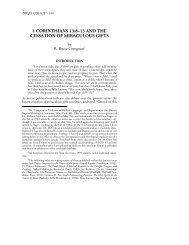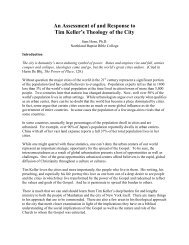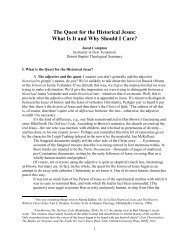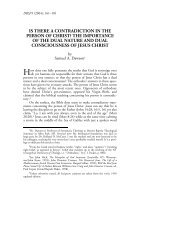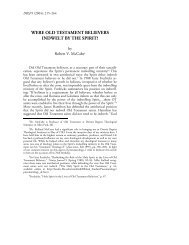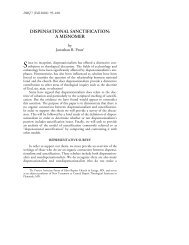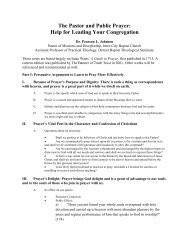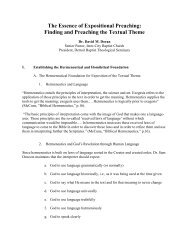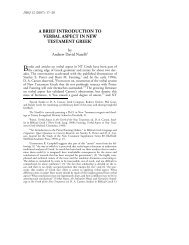Combs, Role of Women in the Church - Detroit Baptist Theological ...
Combs, Role of Women in the Church - Detroit Baptist Theological ...
Combs, Role of Women in the Church - Detroit Baptist Theological ...
Create successful ePaper yourself
Turn your PDF publications into a flip-book with our unique Google optimized e-Paper software.
13T. Shedd, Louis Berkh<strong>of</strong>, Wayne Grudem), and charismatics (G. Rodman Williams). 71H. Even if we supposed that kephalē means “source” <strong>in</strong> 1 Cor<strong>in</strong>thians 11:3, <strong>the</strong> parallelismwith<strong>in</strong> <strong>the</strong> verse is awkward to say <strong>the</strong> least. 72 One could say that man is <strong>the</strong> source <strong>of</strong> <strong>the</strong>woman <strong>in</strong> that Eve was physically taken from Adam and that she had no existence priorto that time. But how is Christ <strong>the</strong> source <strong>of</strong> every man? Adam was not physically takenfrom Christ. We could say that Christ is <strong>the</strong> source <strong>of</strong> Adam <strong>in</strong> <strong>the</strong> he came <strong>in</strong>to existencethrough <strong>the</strong> creative work <strong>of</strong> Christ as creator. But Adam is not <strong>the</strong> source <strong>of</strong> Eve suchthat she came <strong>in</strong>to existence through <strong>the</strong> creative work <strong>of</strong> Adam. And God <strong>the</strong> Fa<strong>the</strong>rcannot be said to be <strong>the</strong> source <strong>of</strong> Christ s<strong>in</strong>ce he was not physically taken from God <strong>the</strong>Fa<strong>the</strong>r or created by him. For egalitarians to say that <strong>the</strong> Fa<strong>the</strong>r is <strong>the</strong> source <strong>of</strong> Christ isexactly what <strong>the</strong> Arians taught. But if kephalē means “authority over,” <strong>the</strong>n <strong>the</strong>parallelism drawn by Paul works well. Christ is <strong>the</strong> authority over every man, and <strong>the</strong>man is <strong>the</strong> authority over <strong>the</strong> woman, and God is <strong>the</strong> authority over Christ.V. Conclusions for M<strong>in</strong>istry Based upon <strong>Women</strong>’s Subord<strong>in</strong>ationA. S<strong>in</strong>ce Paul says that man is <strong>the</strong> authority over <strong>the</strong> woman, how does that affect <strong>the</strong> role <strong>of</strong>women <strong>in</strong> <strong>the</strong> m<strong>in</strong>istry <strong>of</strong> <strong>the</strong> church? Obviously, s<strong>in</strong>ce some functions or <strong>of</strong>fices <strong>in</strong> <strong>the</strong>church <strong>in</strong>volve <strong>the</strong> exercise <strong>of</strong> authority, such as pastor/elder, <strong>the</strong>se would be <strong>of</strong>f limits towomen. This would also <strong>in</strong>clude <strong>the</strong> <strong>of</strong>fice <strong>of</strong> deacon, if, as <strong>in</strong> many churches, <strong>the</strong> <strong>of</strong>fice<strong>in</strong>volves govern<strong>in</strong>g authority. <strong>Women</strong> would also be prohibited from teach<strong>in</strong>g men s<strong>in</strong>ceteachers <strong>in</strong>herently exercise authority over <strong>the</strong>ir students. But egalitarians argue thisunderstand<strong>in</strong>g <strong>of</strong> 1 Cor<strong>in</strong>thians 11: 3 cannot be correct s<strong>in</strong>ce just two verses later <strong>in</strong> v. 5,Paul, it is argued, permits women to engage <strong>in</strong> gospel proclamation m<strong>in</strong>istry when hespeaks <strong>of</strong> women as “prophesy<strong>in</strong>g.”B. If we cont<strong>in</strong>ue with <strong>the</strong> argument <strong>of</strong> our passage, <strong>in</strong> vv. 4–6 Paul draws a conclusionbased upon <strong>the</strong> pr<strong>in</strong>ciple <strong>of</strong> women’s subord<strong>in</strong>ation affirmed <strong>in</strong> v. 3. Paul cont<strong>in</strong>ues <strong>in</strong>v. 4: “Every man who has someth<strong>in</strong>g on his head while pray<strong>in</strong>g or prophesy<strong>in</strong>g, disgraceshis head.” Paul beg<strong>in</strong>s his discussion with <strong>the</strong> men. He seems to be sett<strong>in</strong>g up hisargument with <strong>the</strong> women <strong>in</strong> vv. 5–6 by means <strong>of</strong> a hypo<strong>the</strong>tical situation. 73 If a manwere to have his head covered when pray<strong>in</strong>g or prophesy<strong>in</strong>g, he would br<strong>in</strong>g shame to hishead—Christ. This is so because a head cover<strong>in</strong>g was what women wore to show <strong>the</strong>irsubord<strong>in</strong>ation to men. If a man wore a head cover<strong>in</strong>g, he would be shamefully depict<strong>in</strong>ghimself as a woman. By not conform<strong>in</strong>g to <strong>the</strong> role God <strong>in</strong>tended, <strong>the</strong> man br<strong>in</strong>gsdishonor on himself and his authority, Jesus Christ.C. By way <strong>of</strong> contrast <strong>in</strong> v. 5a, Paul addresses <strong>the</strong> women with a sentence that is an exactparallel with v. 4: “But every woman who has her head uncovered while pray<strong>in</strong>g orprophesy<strong>in</strong>g, disgraces her head.” The woman br<strong>in</strong>gs shame on her “head” if she prays orprophesies with her head uncovered. “Her head” refers to <strong>the</strong> man. This means that she71 Stephen D. Kovach, “Egalitarians Revamp Doctr<strong>in</strong>e <strong>of</strong> Tr<strong>in</strong>ity,” CBMW News 2 (December 1996), p. 1.72 See Hurley, Man and Woman <strong>in</strong> Biblical Perspective, p. 166.73 Fee, Cor<strong>in</strong>thians, p. 504. It is possible that some Cor<strong>in</strong>thian men may have been actually cover<strong>in</strong>g <strong>the</strong>irheads <strong>in</strong> imitation <strong>of</strong> pagan priests who were known to have done so. See W<strong>in</strong>ter, After Paul Left Cor<strong>in</strong>th, p. 122and Gregory J. Lockwood, 1 Cor<strong>in</strong>thians, Concordia Commentary (St. Louis: Concordia, 2000), p. 366.



